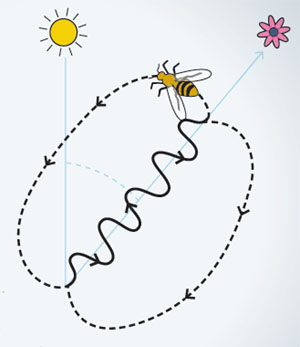Waggle Dancing

You’ve probably heard somewhere before that bees are, collectively, pretty smart. You might also have heard that they communicate information about nearby food sources through a special waggle dance. But do you know how it works?
Honeybee workers occasionally go out to scout for new food sources, and bring that information back to the hive. A returning scout needs to answer three questions about a food source: what it is?, how far?, and in what direction?
Other bees can learn the what by examining the pieces of pollen on the communicating bee’s body. Distance and direction, though, are communicated through the waggle dance:
A waggle dance consists of one to 100 or more circuits, each of which consists of two phases: the waggle phase and the return phase. A worker bee’s waggle dance involves running through a small figure-eight pattern: a waggle run (aka waggle phase) followed by a turn to the right to circle back to the starting point (aka return phase), another waggle run, followed by a turn and circle to the left, and so on in a regular alternation between right and left turns after waggle runs.
The direction and duration of waggle runs are closely correlated with the direction and distance of the resource being advertised by the dancing bee. For cavity-nesting honey bees, flowers that are located directly in line with the sun are represented by waggle runs in an upward direction on the vertical combs, and any angle to the right or left of the sun is coded by a corresponding angle to the right or left of the upward direction. The distance between hive and recruitment target is encoded in the duration of the waggle runs.
Do you realize what this means? Bees communicate about food sources in polar coordinates! That’s so cool, you guys!
I first read about this in Thomas Seeley’s book Honeybee Democracy, a terrific book about how honeybee swarms collectively determine where to live. It’s a textbook of distributed systems algorithms implemented in bees. Which is wonderful.
You might like these textually similar articles:
